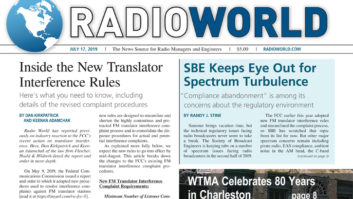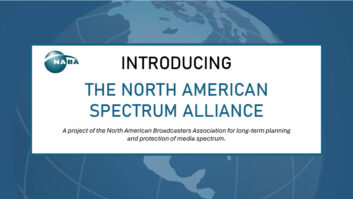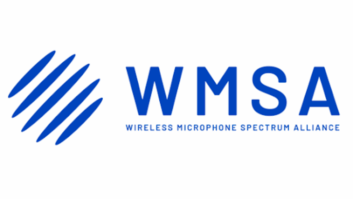
Summer brings vacation time, but the technical regulatory issues facing radio broadcasters never seem to take a break. The Society of Broadcast Engineers is keeping tabs on a number of spectrum issues facing radio broadcasters in the second half of 2019.
The FCC earlier this year adopted new FM translator interference rules and streamlined the complaint process, so SBE has scratched that topic from its list for now. But other major spectrum concerns remain including pirate radio, EAS compliance, ambient noise in the AM band, the C-band versus 5G broadband at 3.7–4.2 GHz, and what the SBE perceives to be FCC compliance abandonment.
The society, which has more than 5,000 members and 114 local chapters, offers educational and certification programs for broadcast engineers, operators, technicians and broadcast IT professionals. But the non-profit also closely tracks technical regulatory topics of interest to its membership.
“FACELESS AND NAMELESS”
Chris Imlay, SBE general counsel, said the group has identified several top areas of concern, including ever-increasing ambient noise in the AM band.
“It seems like we always come back to that issue. I don’t think the FCC wants answers to questions it has asked in the past but never taken steps to explore and investigate,” he said.
“I have preached for years that the typical listener of the AM band is not going to reach out to the FCC to complain about interference issues in the AM band, they will simply not go back to AM.”
Anecdotally, ambient noise in the AM band has grown dramatically worse in the past 15 years due to the proliferation of Part 15 RF devices, RF lighting and deteriorating infrastructure of power lines, Imlay said. SBE’s experiences typically concern ambient, man-made noise in the medium-frequency, high-frequency and VHF bands.
The FCC’s Technological Advisory Council opened a noise floor technical inquiry in 2016 to determine if there is such an increasing problem. Part of the council’s work was to determine the methodology for a noise study.
Imlay said the FCC opened a docket and took comments but never took further action.
“All of a sudden, the docket disappeared and you can’t find it anymore. The FCC gave no further explanation. I don’t think they wanted the answers. It could have revealed the effectiveness of their rules on unlicensed devices. They’re obviously ineffective. Maybe the FCC felt the problem is too big to solve already. Meanwhile, the ambient noise levels are growing worse,” Imlay said.
[Read SBE’s official comments at the time, including a summary of prior FCC discussion of the topic, at https://tinyurl.com/rw-sbe-noise.]
Also, Imlay cites the FCC’s “compliance abandonment” as a growing issue in the field for radio broadcasters.
“The loss of the FCC’s field offices has hurt. They were staffed with experienced engineers. (FCC) lost a huge knowledge base with those moves,” Imlay said.
What the FCC replaced the field offices with was a “faceless and nameless” complaint system, Imlay said, void of any relationship-building.
“The online complaint filing procedure has been a dismal failure. And the FCC even acknowledged up front that they would put in place this new online complaint system but wouldn’t necessarily take any action on individual interference complaints. They said it would be more of an information gathering site,” Imlay said. “It’s really a slap in the face to radio broadcasters.”
And illegal stations remain a major issue, Imlay said.
“Pirate broadcasting is pretty much out of control. Again, that brings us back to the complaint system in place now,” he said.
Imlay acknowledges improved en- forcement of illegal broadcasts early in FCC Chairman Ajit Pai’s tenure, but he feels that less being done in that regard today.
[FCC Media Bureau Upholds Its AM Revitalization Translator Policies]
“Pai is a friend of radio, but I wonder if the FCC’s anti-pirate initiative is still underway. The closing of the field offices remains a big issue,” Imlay said.
The FCC closed more than a dozen field offices beginning in 2017 as part of a restructuring plan in the face of budget reductions. The move was expected to result in the commission trimming up to 44 positions.
Imlay said that he is hopeful the FCC will one day bring back some of the agents it let go in the cuts. “You don’t need the brick and mortar offices to reopen, but additional agents on the ground with mobile vehicles would really help matters. The industry suffers from a lack of bodies and the talent they lost.”
Imlay said the PIRATE Act, which would increase fines illegal pirate operations pay per violation, is making its way slowly through Congress and would help the situation. The bill passed the House of Representatives in February and the Senate Commerce Committee passed it in May. However, the full Senate has yet to take action on the act, after which it would go to the president.
“STILL NERVOUS”
Broadcasters and other users of the 3.7 GHz to 4.2 GHz band remain worried about the FCC’s designs on the spectrum as it seeks means to further feed the appetite of wireless and broadband companies and the 5G rollout.
“A lot of radio users who depend on C-Band distribution for programming are still nervous about what the FCC wants to do,” Imlay said, “and how to ensure the existing C-band operations are fully protected, if some of the 3.7 GHz to 4.2 GHz spectrum is going to be shared with wireless carriers.”
Several compromises have been floated from both camps, according to observers, and Imlay said he expects a final ruling from the FCC before the end of this year.
Other regulatory technical issues SBE is tracking include the discussion over whether to create a new Class C4 for FM and whether an upgraded or new Class C4 station be required to protect existing FM stations to their 45 dBu contour in the same way that was just ordered for FM translators, as some observers hope. SBE hasn’t taken a position on the creation of the new FM class.
In addition, Imlay said with the TV UHF auction completed and TV repack work well underway, there is very little spectrum left in UHF for wireless microphones, which is an issue SBE will track.







